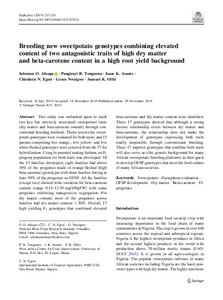| dc.contributor.author | Afuape, S.O. |
| dc.contributor.author | Tongoona, P.B. |
| dc.contributor.author | Asante, I.K. |
| dc.contributor.author | Egesi, C.N. |
| dc.contributor.author | Nwaigwe, G. |
| dc.contributor.author | Offei, S.K. |
| dc.date.accessioned | 2020-05-04T14:30:36Z |
| dc.date.available | 2020-05-04T14:30:36Z |
| dc.date.issued | 2019 |
| dc.identifier.citation | Afuape, S.O., Tongoona, P.B., Asante, I.K., Egesi, C.N., Nwaigwe, G. & Offei, S.K. (2019). Breeding new sweetpotato genotypes combining elevated content of two antagonistic traits of high dry matter and beta-carotene content in a high root yield background. Euphytica, 215(12), 211. |
| dc.identifier.issn | 0014-2336 |
| dc.identifier.uri | https://hdl.handle.net/20.500.12478/6820 |
| dc.description.abstract | This study was embarked upon to stack two key but inversely associated sweetpotato traits (dry matter and beta-carotene content) through conventional breeding methods. Thirty-seven elite sweetpotato genotypes were evaluated for both traits, and 15 parents comprising five orange-, five yellow- and five white-fleshed genotypes were selected from the 37 for hybridization. Using bi-parental mating fashion, an F1 progeny population for both traits was developed. Of the 13 families developed, eight families had above 30% of the progenies made of orange-fleshed (high beta-carotene) genotypes with three families having at least 50% of the progenies as OFSP. All the families (except two) showed wide variation for beta-carotene content (range 0.15–12.39 mg/100gFW) with some progenies exhibiting transgressive segregation. For dry matter content, most of the progenies across families had dry matter content > 30%. Overall, 17 high yielding F1 genotypes that combined elevated beta-carotene and dry matter content were identified. These 17 genotypes showed that although a strong inverse relationship exists between dry matter and beta-carotene, the relationship does not make the development of genotypes expressing both traits totally impossible through conventional breeding. These 17 superior genotypes that combine both traits will also serve as elite genetic background for many African sweetpotato breeding platforms in their quest to develop OFSP genotypes that meet the food culture of many African societies. |
| dc.format.extent | 1-13 |
| dc.language.iso | en |
| dc.subject | Sweet Potatoes |
| dc.subject | Germplasm |
| dc.subject | Dry Matter |
| dc.subject | Carotenoids |
| dc.subject | Food Security |
| dc.subject | Breeding |
| dc.subject | Genotypes |
| dc.title | Breeding new sweetpotato genotypes combining elevated content of two antagonistic traits of high dry matter and beta-carotene content in a high root yield background |
| dc.type | Journal Article |
| cg.contributor.crp | Roots, Tubers and Bananas |
| cg.contributor.affiliation | National Root Crops Research Institute, Nigeria |
| cg.contributor.affiliation | University of Ghana |
| cg.contributor.affiliation | International Institute of Tropical Agriculture |
| cg.coverage.region | Africa |
| cg.coverage.region | West Africa |
| cg.coverage.country | Nigeria |
| cg.coverage.hub | Headquarters and Western Africa Hub |
| cg.creator.identifier | Chiedozie Egesi: 0000-0002-9063-2727 |
| cg.researchtheme | Biotech and Plant Breeding |
| cg.identifier.bibtexciteid | AFUAPE:2019 |
| cg.isijournal | ISI Journal |
| cg.authorship.types | CGIAR and developing country institute |
| cg.iitasubject | Agronomy |
| cg.iitasubject | Food Security |
| cg.iitasubject | Nutrition |
| cg.iitasubject | Plant Breeding |
| cg.iitasubject | Plant Health |
| cg.iitasubject | Plant Production |
| cg.journal | Euphytica |
| cg.notes | Published online: 29 Nov 2019 |
| cg.accessibilitystatus | Limited Access |
| cg.reviewstatus | Peer Review |
| cg.usagerightslicense | Copyrighted; all rights reserved |
| cg.targetaudience | Scientists |
| cg.identifier.doi | https://dx.doi.org/10.1007/s10681-019-2532-0 |
| cg.iitaauthor.identifier | Chiedozie Egesi: 0000-0002-9063-2727 |

